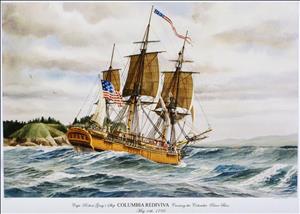On May 11, 1792, American fur trader Robert Gray (1755-1806) enters the major river of the Pacific Northwest in his ship the Columbia Rediviva. Indian peoples have lived and navigated along Wimahl ("Big River") for tens of thousands of years, and Europeans have been sailing the Northwest Coast for more than 200 years. However, Gray is the first non-Indian to succeed in entering Wimahl, which he renames the Columbia River after his ship.
Life on Big River
According to tradition, people lived along Big River since the time Coyote traveled up it from the ocean to the mountains, making the world ready for people. Archeological research has documented more than 10,000 years of human activity on the lower Columbia. For 200 river miles, from the ocean to above The Dalles, Wimahl was home to peoples speaking several related Chinookan languages, beginning with the Chinook on the north bank and the Clatsop on the south side.
For many miles on both sides, the banks of the river were studded with villages of large rectangular longhouses constructed of huge cedar planks. The natural abundance of the region, including five types of salmon, wapato, camas, and other bulbs, berries, and many other plant and animal resources, sustained a complex material and social culture, and made the lower Columbia one of the most heavily populated and richest areas north of Mexico.
Europeans Reach the Coast
The first European navigators reached the northwest coast of North America in the 1500s, with Spaniards sailing up from Mexico soon followed by British Captain Sir Francis Drake on his around-the-world voyage in the Golden Hind. Russians arrived from Alaska in the 1700s, inspiring further Spanish expeditions up the coast to claim the area for Spain. All these Europeans hoped to find the Northwest Passage, the fabled water route from the Atlantic to the Pacific across the top of North America.
Despite looking for this great waterway to the east, no European navigator appears to have detected the mouth of the Columbia until Bruno Heceta (Hezeta) in 1775. In August of that year, sailing along the coast at latitude 46 degrees, 10 minutes, Heceta found himself off what appeared to be a great river. He was short-handed, and the currents were strong, so he reluctantly took the advice of his officers and did not attempt to enter the river.
Heceta named the cape at the north of the river mouth Cabo de San Roque and that on the south Cabo Frondoso. He called the entrance, which he considered a bay, Ensenada de Asuncion. Subsequent Spanish charts showed a river, labeled Rio de San Roque, based on Heceta's reports.
British Disappointment
To their subsequent regret, the British doubted the Spanish reports. In 1788, British fur trader Capt. John Meares (1756?-1809) rounded Cabo de San Roque in search of the reported river. He found the water shoaling rapidly, and thought that breakers extended all across the entrance. He concluded, mistakenly, that the river shown on the Spanish charts did not exist, and departed.
Meares renamed Cabo de San Roque as Cape Disappointment, a name that remains in use even though Meares' disappointment was based on his own error. Meares' error influenced British Royal Navy commander George Vancouver, when he sailed past the mouth of the Columbia in April 1792. Vancouver noted that the sea changed color at the Columbia's mouth, but he accepted Meares' report and did not investigate further.
Gray Enters Big River
Less than two weeks later, American Robert Gray proved Heceta right and Vancouver wrong when he succeeded in entering the Columbia. Gray, a Rhode Island born captain in the employ of a consortium of Boston merchants, was on his second voyage to the Northwest in search of sea otter and other furs. On his first voyage around Cape Horn and up the Pacific Coast in 1788, he had noted a strong current at the mouth of the Columbia. In April, 1792, on his second voyage, he again detected the river and tried to enter it, but was prevented by bad weather.
Then on May 11, 1792, after leaving Grays Harbor, Gray succeeded in sailing the Columbia into the great river that now bears the ship's name. He spotted the entrance early in the morning, and with favorable weather and wind conditions was able to cross the bar and enter what he described in his log as "a large river of fresh water" (Nokes, 191).
Gray remained in the lower Columbia for nine days, filling his ship's casks with its fresh water and trading with the Chinook people who lived along its banks. The Chinooks told Gray and his crew that there were more than 50 villages along the river. The ship was often thronged with local inhabitants, who appeared never to have seen a sailing ship before. Trade was heavy, and the crew collected 150 otter skins, 300 beaver skins, and many more skins of land animals.
What's in a Name
On May 19, 1792, a day before sailing back to sea, Gray formally named the river Columbia. Although the immediate source of the name was Gray's ship, there was considerable symbolic value to the name derived from Christopher Columbus and used in many aspects by the young United States. Indeed, by entering the river before the British, Gray not only determined the name of the river, but gave the United States its strongest claim to the Northwest Coast of North America.

